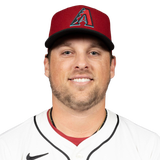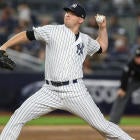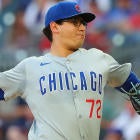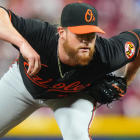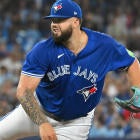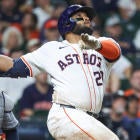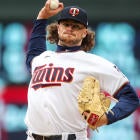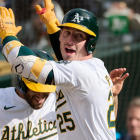Wednesday on the Fantasy Baseball Today podcast, we dove into ranking closers solely based on job security. It's a fun exercise, especially when competing in Roto leagues. While Edwin Diaz has a ton of upside and Nick Anderson might give you ridiculous ratios, both present huge downside in the saves category. What happens if Diaz picks up where he left off in 2019? The Mets have more depth and talent now in their bullpen. As great as Anderson was with the Rays, manager Kevin Cash has been known to use a closer-by-committee. That changes how you should value closers when you want to be competitive in the saves category.
We setup six tiers of job security when ranking these closers. It became a little convoluted on the podcast so I thought it was a good idea to list those out for you here. For the most part, we came to a consensus on the job security on most, if not all, of the closers in baseball.
Let's start things off with the top tier:
The Strongest
- Padres: Kirby Yates
- Astros: Roberto Osuna
That's it for Tier 1, just two names. Yes, the Padres have great options behind Yates and his name has been floated about in trade rumors, but he's arguably the best reliever in baseball. Over the past two seasons, his 1.67 ERA ranks first among qualified relievers while his 0.91 WHIP ranks second. His splitter is one of the best weapons in baseball. As for Osuna, he's as steady as they come. In his first season with the Astros, all he did was post a 2.63 ERA and 0.88 WHIP with 38 saves, which ranked second in baseball. For those asking, "but where's Josh Hader?" Reminder: these aren't just Fantasy rankings. There are a few concerns regarding Hader's role in 2020.
Next up, Tier 2.
Very strong but …
- Brewers: Josh Hader
- Yankees: Aroldis Chapman
- Indians: Brad Hand
- Blue Jays: Ken Giles
Still only four names in this tier. Are you noticing a theme? The closer position is most volatile of all. There are very few closers we trust in terms of their job security. Everybody in this tier has at least one concern, which gave us a reason not include them in Tier 1. Hader makes his way into this tier for two reasons: Corey Knebel is set to return from Tommy John surgery, and the Brewers have shown they may prefer Hader in a multi-inning role in the past. The last time we saw Knebel, he led the team with 16 saves in 2018, and from 2017-2018, Knebel's 40.2% strikeout rate was fourth best among qualified relievers. He's not Hader, but at his best he was pretty close. And, let me remind you that Craig Counsell is still this team's manager. He has always preferred Hader in that multi-inning role. Last season he just didn't have a choice. Knebel could change things.
As for the other three, Chapman has a history of injuries and won't be ready for the start of the season after testing positive for COVID-19. Chapman should have plenty of job security when he returns to the team, but it'll be Zach Britton getting saves to start the season. Meanwhile, Hand struggled in the second half (and has a capable James Karinchak waiting; more on him later), and sometimes Giles can lose his cool under pressure.
He's the guy but even more concerns …
- A's: Liam Hendriks
- Dodgers: Kenley Jansen
- Cubs: Craig Kimbrel
- Twins: Taylor Rogers
- Red Sox: Brandon Workman
- Reds: Raisel Iglesias
- Phillies: Hector Neris
- Pirates: Keone Kela
- Angels: Hansel Robles
- White Sox: Alex Colome
Tier 3 features the most closers with 10. On the podcast, Chris Towers mentioned that this exercise would look like a bell curve and that makes sense (see graph below). There are way more closer situations we're worried about than ones we're not. While you might have had just one or two concerns over closers in the previous tier, there are even more to worry about with this group.
I won't run through each name here, but let's just take a look at the top three options in this tier. Hendriks broke out in 2019, but questions remain. Can he maintain the added velocity? If he struggles, can he fend off names like Yusmeiro Petit and Joakim Soria? The A's haven't had a repeat saves leader since 2012-2013 when Grant Balfour pulled that off.
Jansen and Kimbrel seem to be in similar spots this season. Undoubtedly, they're the closer for their teams, but how can you not have a decent level of concern on each? Jansen's velocity has been trending down as is his production. The Dodgers also have a former elite closer on their roster in Blake Treinen. Kimbrel, meanwhile, finally got his money in June last season, but his production did not match his salary. He only made 23 appearances but pitched to a 6.53 ERA plus his velocity was down. This is likely the last tier you somewhat trust your closer's job security.
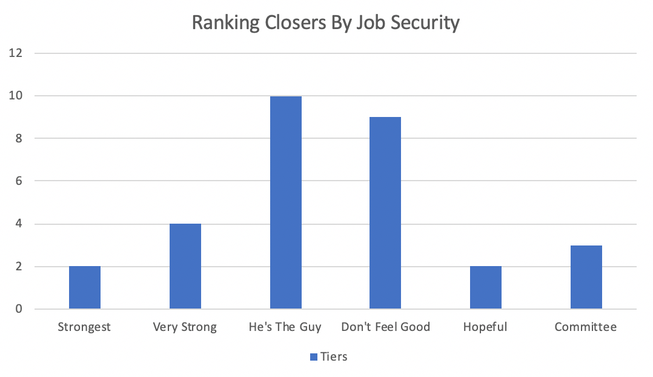
Closer but don't feel good about it
- Mets: Edwin Diaz
- Diamondbacks: Archie Bradley
- Rangers: Jose Leclerc
- Nationals: Sean Doolittle
- Braves: Mark Melancon
- Royals: Ian Kennedy
- Tigers: Joe Jimenez
- Rockies: Wade Davis
- Marlins: Brandon Kintzler
Eight more names appear in this tier, and let's address the elephant in the room. Yes, Diaz belongs here. Honestly, I think he's just as likely to lose his job as Wade Davis. Diaz was tied for the second-most blown saves in the National League last season with seven. He absolutely has the upside to be great, evidenced by his 2018, but we must weigh his 2019 for the atrocity that it was. Not only that, the Mets are expected to be competitive and have two very capable pitchers on hand in Dellin Betances and Seth Lugo.
Each name in this tier has significant concerns. The one I would argue should be in a higher tier is Archie Bradley, but his walk rate is a problem and he doesn't get enough swings and misses. Outside for Diaz, each of these closers should be viewed as a low-end RP2, high-end RP3 in roto leagues.
Hasn't been named closer but we're hopeful
- Rays: Nick Anderson
Anderson has filthy stuff, and if he earns 75% of the Rays' save opportunities, he'll probably be a top-five closer in Fantasy. There's just no way of knowing for sure. For a reminder of just how great he was: His 41.7% strikeout rate in 2019 ranked second among qualified relievers behind only Hader.
Committee/position battle
- Giants: Tony Watson vs. Trevor Gott vs. Tyler Rogers
- Mariners: Matt Magill vs. Yoshihisa Hirano
- Orioles: Hunter Harvey vs. Mychal Givens
- Cardinals: Ryan Helsley vs. Andrew Miller vs Giovanny Gallegos (eventually)
Yikes. What more needs to be said? You have four closer-by-committee position battle, with three coming on the worst teams in baseball. While Watson has the most experience of the group, he's probably the one I trust the least and it has nothing to do with him. Gabe Kapler, Giants manager, was notorious for his frustrating bullpen usage in his previous stint with the Phillies. As somebody who's consistently owned Hector Neris in the past, I can confirm I'll be staying away. Oddly enough, I feel like Hunter Harvey has the most upside of the group. Orioles manager hinted at Harvey seeing opportunities last month and, if nothing else, he throws hard and is a former top prospect.
As for the Cardinals, we had hoped it would be Gallegos' job, but he likely won't be available to start the season because he hasn't even reported to camp yet, which means Helsley looks like the default option. He isn't terribly exciting, so if Gallegos gets back to the team relatively soon, he remains a good sleeper for saves.
Since you've made it this far, I'll offer you a bonus. Below I've provided my favorite dark-horse relievers to take over his team's closer role for the 2020 season. You know about the obvious ones already with Will Smith, Scott Oberg and Daniel Hudson. Who is this year's Liam Hendriks? I have a few names in mind.
| ||||||||||
I mentioned there'd be more on Karinchak later. Now is later. The guy is a freak. In 102.1 innings pitched in the minors, he had 186 strikeouts. He also saved 22 games, so he's had a taste in that role. Brad Hand struggled big time in the second half with a 5.40 ERA and four blown saves. If he goes through another stretch like that in 2020, I do believe Karinchak has what it takes to step in. If you've never seen him pitch, please change that. He's got this unique delivery that allows him to hide the ball extremely well. His fastball sits in the upper 90s with a wipeout hammer of a curveball.
| ||||||||||
For Aaron Bummer, it's a combination of confidence in him and lack thereof in Alex Colome. Bummer pitched to a 2.13 ERA and 0.99 WHIP in 2019. Before you bring up the fact that he's a lefty, he did fantastic job neutralizing both sides of the plate last season. While he allowed just a .446 OPS to left-handed batters, he also allowed just a .563 mark to righties. For Colome, his 2.80 ERA might look peachy, but his 4.61 xFIP certainly does not. We've seen some big save totals out of Colome in the past, so he has the track record, but his underlying numbers suggest he'll come crashing down sooner rather than later.
| ||||||||||
Adam Aizer brought up a solid point in defense of Bradley on the podcast, and that's competition. There isn't much to speak of in the Diamondbacks bullpen, except Kevin Ginkel. He pitched in just 25 games last season but made a lasting impression with his 1.48 ERA and 0.99 WHIP. Throughout his minor-league career, Ginkel was used strictly as a reliever and was dominant. In 166.1 innings, he managed 239 strikeouts with a 2.60 ERA and 1.01 WHIP. Bradley has been a bit inconsistent over the past two seasons, and if the walks continue to be an issue, I think Ginkel steps in. Over the final two weeks last season, Bradley recorded four saves while Ginkel nabbed two.
| ||||||||||
Admittedly, these last two are long shots but when it comes to Trevor Rosenthal, "What's dead may never die". Rosenthal finds himself with the Royals, reunited with his former manager Mike Matheny. Under Matheny, Rosenthal enjoyed his greatest success. Over the course of 2014 and 2015, Rosenthal amassed 93 saves, the most by a reliever during that stretch. When Matheny was asked about assumed closer Ian Kennedy in the role, he was noncommittal. Also, I know we're not supposed to care about spring training stats, but in five appearances, Rosenthal had nine strikeouts with zero walks. I don't believe we've seen the end of him yet.
| ||||||||||
I want to trust Jose Leclerc, but he just makes it so hard. He has some of the best stuff in baseball but half the time, he has no clue where it's going. He's made 188 appearances in the bigs and owns a 5.63 BB/9, which is less than ideal. Most will point to Rafael Montero as the handcuff, but I believe the name to watch is Demarcus Evans. Who? Evans is a prospect in the Rangers organization who's been used exclusively as a reliever since the start of 2018. Since then, he's yet to post a swinging strike rate lower than 17.1% at any minor-league level. Just last season, he posted a 0.90 ERA and a 1.03 WHIP with 100 strikeouts in 60 innings pitched between High-A and Double-A ball. Remember that name in AL-only and deeper mixed leagues.













